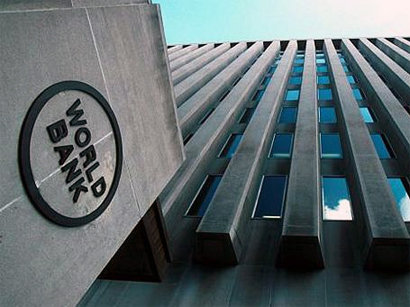WB improves forecast for Azerbaijan’s economic growth

By Mirsaid Ibrahimzade
World Bank (WB) expects Azerbaijani economy to grow by 3.3 percent in 2019, 3.5 percent in 2020 and by 3.7 percent in 2021, based on renewed report on Europe and Central Asia.
Compared with the previous report, forecasts for growth in Azerbaijan’s economy have increased by 0.2 and one percent, respectively.
Azerbaijan’s economy expanded at a moderate pace in 2018 aided by stable oil production and a modest pick-up in domestic demand, as higher oil earnings boosted fiscal spending and real wages rose. As a result, real GDP in 2018 increased by 1.4 percent.
Supported by stable oil production and a modest acceleration in domestic demand, real GDP expanded by 1.4 percent in 2018. While oil production plateaued, the hydrocarbons sector overall posted growth of 1.1 percent thanks to higher exports of natural gas. The non-energy economy expanded by 1.8 percent, reflecting greater dynamism in most economic sectors.
On the demand side, the expansion was mainly driven by consumption, as higher oil and gas prices supported an increase in public spending and real wages. A modest recovery in credit also supported demand. Total investment continued to contract in 2018, though at a more moderate pace, while non-energy sector investment jumped by 22 percent year on year.
Higher oil prices propelled the current account surplus to 15 percent of GDP (a non-energy deficit of 10 percent of GDP) in the third quarter of 2018. Oil exports rose by 44 percent year on year, while non -oil sector exports increased by 12 percent. Imports also rebounded, rising by 25 percent, buoyed by increased government consumption and stronger domestic demand.
International reserves rose to $5.6 billion, the assets of the State Oil Fund of Azerbaijan reached $38.5 billion (82 percent of GDP), and the manat remained stable against the U.S. dollar. In contrast, the real effective exchange rate appreciated by 5.5 percent. Consumer price inflation decelerated sharply in 2018, falling to 1.6 percent from 7.9 percent in 2017, reflecting modest domestic demand, low external inflationary pressures. In response, the Central Bank of Azerbaijan (CBA) gradually lowered its policy rate to 9.25 percent by February 2019 (from 15 percent in December 2017).
Higher oil revenues helped boost fiscal spending in 2018 (up by 29 percent year on year), mainly through higher public investment. The consolidated budget recorded a surplus of 5.9 percent of GDP (compared to a deficit of 1.5 percent of GDP in 2017), while the non-energy deficit widened to 33 percent of non-energy GDP.
The State Statistical Committee estimates that the national poverty rate fell from 5.9 percent in 2016 to 5.4 percent in 2017. The poverty rate is estimated to have fallen further in 2018 in response to continued economic expansion, low unemployment, rising real wages, and modest inflation.
WB says that primarily owing to rising natural gas exports, economic growth in the medium term is forecasted to average 3.5 percent annually. Non-energy output is projected to expand at around 3 percent annually, supported by domestic demand, as real wages and credit to the economy continue to improve.
In 2019, private consumption will receive a temporary boost from increases in the minimum wage and minimum pension. Meanwhile, recent tax reforms and ongoing efforts to reform the customs system—building on Azerbaijan’s strong business reform performance in 2018—could reduce informality and translate into greater economic activity.
So, sustained GDP growth, additional social transfers, and low unemployment levels will translate into further reductions in the poverty rate. However, more significant poverty reduction may require policies tailored to the specific segments of the population where the poverty incidence remains highest.
Touching upon current risks and challenges mentioned in the report, Azerbaijan's economy faces both external and domestic uncertainties. A global economic slowdown or rising geopolitical risks in major oil suppliers could impact oil prices and hurt Azerbaijan’s growth prospects.
Simultaneously, the notable increases in the 2019 budget allocations for education (up by 13 percent) and health care (by 44.5 percent) are important in terms of improving human capital. But further efforts are needed to align budget spending with development needs, including through strengthening medium-term budgeting and the Public Investment Management system.
As a conclusion, report informs that with no major decline in oil prices and a boost in gas exports, the current account surplus is likely to remain above 12 percent of GDP over the medium term. Imports will continue to recover reflecting trends in domestic demand. Capital outflows are expected to remain low.
---
Follow us on Twitter @AzerNewsAz
Here we are to serve you with news right now. It does not cost much, but worth your attention.
Choose to support open, independent, quality journalism and subscribe on a monthly basis.
By subscribing to our online newspaper, you can have full digital access to all news, analysis, and much more.
You can also follow AzerNEWS on Twitter @AzerNewsAz or Facebook @AzerNewsNewspaper
Thank you!
